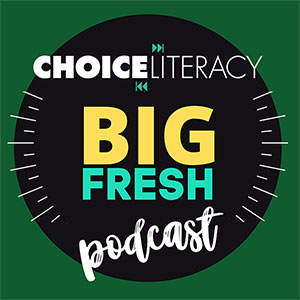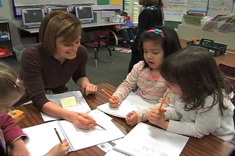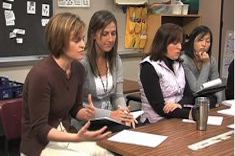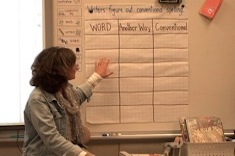Katie DiCesare chats with Franki Sibberson about word learning in Katie’s first-grade classroom. A full transcript is available below the player.

Franki Sibberson: Katie, you’ve been thinking about word study for quite a while in the primary classroom. How do you define word study in your classroom?
Katie DiCesare: Word study in my room I think it’s kind of hard to define, because I feel like in my mind I might even think of it more as this idea of word learning because I think with our primary kids they’re so new to words in terms of reading them and writing them. But if I think of like just those two words that you said, word study, I think about that as a time for talking about and exploring letters, sounds, patterns or words together and I think we feel like that as teachers, like it’s the 15 minutes that we kind of talk more explicitly about the concepts that we have to teach because we have a lot to teach. But I almost want to just like say let’s expand our definition and really think about what our kids are doing with words as readers and writers and how are they learning words so that’s kind of my take on it, because I have this kind of lens where I’m really looking at my kids as word learners but I also really think of them as readers and writers so I think they’re essentially the same and so in my mind I’ve kind of created this place where they can be so I’ll talk a little bit more about that, too.
Franki Sibberson: I love that word learning instead of word study. That makes sense. It does change the whole way we think about it, I think.
Katie DiCesare: Yeah.
Franki Sibberson: So when you think about your K-2 kids, what focus do you have in terms of what students understand about words –
Katie DiCesare: Okay, so –
Franki Sibberson: and the content, I guess.
Katie DiCesare: Yeah, I know and I definitely have this, so I have this like frame where I’m thinking of words that each of this like reading and writing lens. So my focus with my word learners really is like okay, what can they do well and what do they need next as they read and write, and I think there’s so many different areas for us in terms of content. Because they’re new and applying that learning to their own reading and writing words, I mean, one of the first areas that I focus on really is illustration, because I know my kids’ understanding of really a story and all the words in the story are going to be based on their interpretation of the illustration. That’s gonna guide their – the meaning of the story for them. So and as well as thinking about the illustrations, that also is a place that they actually begin telling their own story. So illustrations are one of my biggest focuses at the beginning of the year as well as throughout the year, I should say. I also pay attention to how my kids are hearing language. Can they rhyme, especially can they identify sounds right at the beginning of words and end of words? So are they using this phonological learning in their own reading and writing, as well? And it’s kind of like that scaffold system, ‘cause I did say can they rhyme, can they hear sounds? It’s what we do together in a lot of the shared reading work that I’m listening and paying attention to kids and then are they taking that and are they applying those concepts in their own reading and writing? I pay attention also to high-frequency words. I think that’s another big area. You know what words are they easily reading in text on their own? Do they have kind of practice high-frequency words? Hopefully, they have a chunk of time where they’re showing us what they know and if they don’t know words you know how will I help them learn some of those words and solidify them? I also pay attention to the whole notion of letter-sound relationships and I really kind of chunk those together and think about that in my mind as patterns. Are they confusing diagraphs as they read or digraphs as they read? We need to hit those harder. Are they familiar with spelling patterns? Are they writing those? Are they using them in their own writing and making connections to things they’ve seen or heard or we’ve learned? And then I think another big area that I focus on is this whole notion of like word structure and vocabulary. Are my kids writing and reading suffixes? And I think in the really primary grades we look at endings like ‘s’ and ‘ing’ and ‘ed’ in terms of suffixes, and then with vocabulary are they understanding new words? They hear me read, are they asking questions about new words they hear me read, and the later in their own reading and writing are they beginning to do that, as well? And I don’t think this is an exhaustive list of things but it’s a really kind of nice focus where I can help them learn words within their own reading and writing.
Franki Sibberson: That makes sense. That’s a lot, too, to keep track of.
Katie DiCesare: It is a lot.
Franki Sibberson: And I – so when you really, you really focused on this work. What are key things you’ve learned about embedding authentic word work for young readers and writers so that it’s not isolated kind of skill and drill?
Katie DiCesare: Yeah, I know I feel like I’m still learning that, too. So I started to think about three – I think there is maybe three or four things here. One of the things and I might have already said this but I think we have to tell ourselves this over and over again is that we’re going to need time to read and write. That’s when they show us really what they know about words so with that, I’ve really learned that I have to really listen to what my students understand about words. So I have to give them time to share and reflect not only with me but with one another, whether it’s in – during word study or maybe a share time during workshop, I have to ask them questions like what’s going well for you, what strategies are helping you problem-solve these words or what’s your thinking behind the strategy? What’s your thinking behind the strategy that helped you write that word in their own writing? How did you know the high-frequency word or how did you know how to write that longer word? When I give them time for them to talk with me or each other they begin to teach one another and then the learning becomes that collaborative community piece and they own it way more than me just telling them they need to know these things. I’ve also learned that we have to help kids make connections about those explicit concepts that we teach during word study. We have to help them in their – in kids’ reading and writing. We have to say you know we have to support them, basically. And I think about that book that Debbie Miller just came out with and Barbara Moss. It’s called, No More Independent Reading without Support. It’s kind of like the same notion. No more – and we want kids to be independent. I should say no more independence without our support of words for kids, you know?
In the primary grades we support them with anchors like word walls and name charts and bell charts, but oftentimes when we have a conversation or a connection or a student can do that with one another that helps them so much more. They might even need that extra scaffold to say – have somebody point that out – hey you know you’re writing scored where? It looks – it doesn’t look quite right. Let’s talk about it and find it somewhere in this book, like Where is the Green Sheep? because we’ve read this book lots of times and maybe you can remember it as you remember the story that Mem Fox wrote. So just – and that’s a very simple example but I think they need that same type of explicit connecting and then even more so with that connecting, connecting them with real authors that we’re, you know, that they’re reading about in the classroom because that makes it even more meaningful, I think.
Franki Sibberson: Thank makes sense. So are there routines that you rely on to make sure this happens for seeing growth in word study?
Katie DiCesare: Yes. I would say that because of – because they need time to read and write, there’s – I’m a reading, writing workshop teacher, so they have to have time to apply what we’re teaching them in word study to their independent time in reading and writing workshop so that – those are two big routines that I use throughout the day. Interactive writing I use really, especially at the beginning of the year with my kiddos, it’s a time where we can write together and I can begin to model a little of the process and once I model my thinking for words then, I’m noticing other kids jump into the conversation. It becomes a lot more collaborative so that we’re all learning from one another, and it’s really good for my kids at the beginning of the year just to get them thinking about how to get the words on the page and how to make connections, the things we’ve learned or names in our room or whatnot. And then later on in the year if I still have kids that need the support of writing together, I’ll use kind of a guided group as more of a routine rather than the whole class, because I often find kids – a lot of my kids catch on to it and they’ll grow out of that need for that scaffold so I could I just pull a guided group. I mentioned earlier shared reading and I think that that is just a huge routine that I use, again, especially at the beginning of the year, because we can read a text together and it gets them to really feel, I should say, it gets them – yeah, it gets them to just to feel happy to enjoy books. At the same time, they’re practicing fluency and they’re getting to know authors and how we read. So it –
Franki Sibberson: That makes sense. That’s a lot of routine. [Laughter]
Katie DiCesare: Yeah, I know. I’m like I’m sorry, it’s a lot of routine.
Franki Sibberson: No, you have a lot of stuff in place. It’s great.
Katie DiCesare: But they also kind of get – they also kind of stayed out of the way as the year goes by. They’re not things that you do every single day, and you kind of have – and this is what I’m trying to think about on my own, too, is that we have to listen to our kids so if there’s not time for this every day we make time for what works and what we can do and what works for them.
Franki Sibberson: That makes sense. So all these things that you’re doing, what kind of assessments and recordkeeping help you see student growth over time?
Katie DiCesare: I think we’ve been talking about this before that there is like district assessments, some bigger pieces like the developmental reading assessment, the developmental story assessment, we have high-frequency checks and a dictation sentence, and I really like the – these are big summative pieces, but for the day-to-day planning I really rely on what my kids are doing in their own reading and writing. So I will really look at students’ independent writing and the conversations I have with them and listen to their process to help me plan for what they need next. And then reading it’s, again, those conversations I’m having with kids about the strategies they’re using and running records that I take.
Franki Sibberson: Wow. Okay, so things embedded again like, I mean that’s been kind of a pattern that I’m listening to –
Katie DiCesare: Yeah.
Franki Sibberson: just embedded throughout a good reading and writing workshop.
Katie DiCesare: Yeah.
Franki Sibberson: So, finally, do you have some favorite books or resources that really helped your young students learn how to understand words? Did it work?
Katie DiCesare: Yes. I think and you know when I read this question, too, I was thinking okay, so I think that we can also like turn that – this reading-writing lens on and we can think about how really every book has something to help kids learn about words. So if we take this notion that books are filled with words and each one of them has something that we could notice and teach, really we can use any book to help our kids really learn about words and that’s kind of how I think. So I’m just gonna share a couple that have helped my kids and why they helped my kids this year, at the beginning of the year, Twenty-six Princesses and Pirates. My kids love this book and it rhymes, it has names and they love to pretend like they’re one of the princesses. It has pictures that they can notice and they do the bigger work of understanding new words simply on the pages. It’s an alphabet book, as well, so we talk about letters. It’s just filled with all these different areas of word learning but it’s so meaningful and they just love it. And there’s another one – I talked about the princess one. There’s another one – Twenty-six Pirates by Dave Horowitz so it’s really good. So the guys – the boys love it, too, ‘cause it’s almost like – theirs is like the princesses and the pirates and there’s this little frog that they get to pay attention to, too, and it – they just love it and there’s so much you can talk about with word learning in these two books. I also wanted to say Elephant and Piggie books and I know that everybody knows these books but really these are the basis of helping kids learn to read because they’re filled with two really funny, adorable, relatable characters and they’re filled with high-frequency words. Like these kids just really digest high-frequency words by reading Elephant and Piggie books by Mo Willems, and I think we have to start looking for books that are like that to help our kids so that they have like other series books. So I was thinking like Max and Milo by Heather and Ethan Long is one that reminds me of Elephant and Piggie because there’s just – they’re brothers and one brother can’t fall asleep and the other – so he’s bugging the other brother who is falling asleep, but it’s very graphic novel-like but very, very funny and fun. And then Frog and Fly by Jeff Mack is very similar to Elephant and Piggie and Max and Milo, because there’s two characters working and lots of word bubbles in this story and lots of high-frequency words and they just really – the kids just love ‘em and laugh and they’re really practicing with good, strong picture books.
Franki Sibberson: I love your idea of just any word can help kids with word learning. That makes sense. It does, again, it goes back to what you said at the beginning about expanding our ideas about word study and making it bigger.








